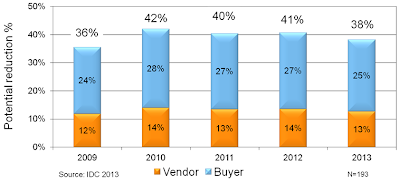Most marketers in B2B enterprises have never been trained on sales process. If I were running your marketing or sales organization this would be the first thing on my agenda. Why? Because without understanding sales process, marketing is essentially set up to fail. How can anyone improve or contribute effectively to something if they don’t know how it works. It’s like setting up your manufacturing to produce blue widgets but not telling your suppliers what parts you need for your particular widgets. So they ship you tons of blue stuff and hope that somehow it all works out. That’s the position, to one degree or another that most enterprise marketing organizations are in even at some of the most advanced process-centric companies in the world. Largely because they have chopped up the customer creation process into a collection of departmentally independent activities.
In a large enterprise with many products lines, business units and segments, there are likely to be a number of different sales processes. Marketing and sales resources should be aligned against these processes horizontally. This is the key to making the shift from a siloed command and control organization to a responsive, integrated customer focused one. Not only is it important to design around sales process, which should be designed around the buyer’s journey, but it is important to design for change. Markets are dynamic and sales processes change.
Marketing automation systems, especially those that are integrated with the sales force automation or customer relationship management system, have begun to provide marketing with some clues to sales process. At least they can see what happens or does not happen when they deliver something to sales. But the data does not always explain why, and that’s the critical part. Marketing needs to understand very specifically how Sales operates in order to optimize around customer outcomes. The alternative is for marketing to optimize around departmentally focused KPIs like the number of MQLs (ugh), or SALs, or worse vanity metrics like hits, sentiment, likes, etc. These metrics are useful indicators for some marketing activities, but not as business drivers for marketing investment.
Aligning marketing and sales around sales process is the first step to formulating an enterprise customer creation process that extends across all customer touch points, including: billing, fulfillment, service and support. At each stage of maturity, marketing, as well as all the other customer facing departments, gain much greater visibility and accountability to the whole process and its connection to corporate objectives for growth, market share, and margin. This is all necessary for a true picture of marketing ROI.
Your action items:
- Marketers: lobby your top executives to make regular sales process training for marketing a priority.
- Sales executives: demand that marketing know how the different parts of your sales force work so they can more effectively develop prospects and serve customers.
- CEOs: get smart about your customer supply chain by applying the same level of due diligence and process discipline to it that you have to your product and services units. As a result, you will make much more effective use of marketing investment and be able to hold your whole customer facing team accountable for its contribution to your strategic objectives.



